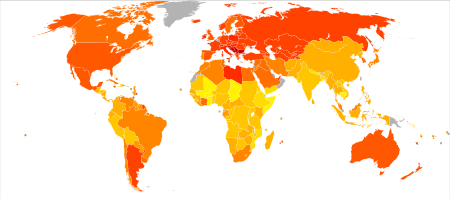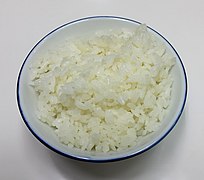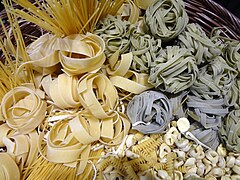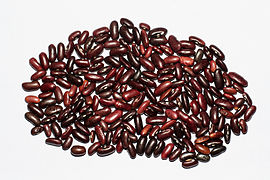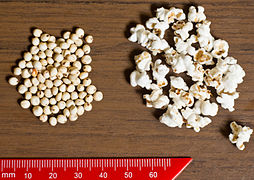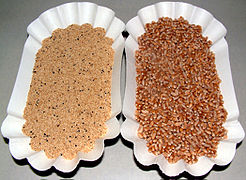
A cereal is a grass cultivated for its edible grain. Cereals are the world's largest crops, and are therefore staple foods. They include rice, wheat, rye, oats, barley, millet, and maize. Edible grains from other plant families, such as buckwheat and quinoa are pseudocereals. Most cereals are annuals, producing one crop from each planting, though rice is sometimes grown as a perennial. Winter varieties are hardy enough to be planted in the autumn, becoming dormant in the winter, and harvested in spring or early summer; spring varieties are planted in spring and harvested in late summer. The term cereal is derived from the name of the Roman goddess of grain crops and fertility, Ceres.

Manihot esculenta, commonly called cassava, manioc, yuca, or tapioca is a woody shrub of the spurge family, Euphorbiaceae, native to South America, from Brazil, Paraguay and parts of the Andes. Although a perennial plant, cassava is extensively cultivated in tropical and subtropical regions as an annual crop for its edible starchy root tuber, a major source of carbohydrates. Cassava is predominantly consumed in boiled form, but substantial quantities are processed to extract cassava starch, called tapioca, which is used for food, animal feed, and industrial purposes. The Brazilian farinha, and the related garri of West Africa, is an edible coarse flour obtained by grating cassava roots, pressing moisture off the obtained grated pulp, and finally drying it.

Porridge is a food made by heating or boiling ground, crushed or chopped starchy plants, typically grain, in milk or water. It is often cooked or served with added flavourings such as sugar, honey, fruit, or syrup to make a sweet cereal, or it can be mixed with spices, meat, or vegetables to make a savoury dish. It is usually served hot in a bowl, depending on its consistency. Oat porridge, or oatmeal, is one of the most common types of porridge. Gruel is a thinner version of porridge and congee is a savoury variation of porridge of Asian origin.

CGIAR is a global partnership that unites international organizations engaged in research about food security. CGIAR research aims to reduce rural poverty, increase food security, improve human health and nutrition, and sustainable management of natural resources.
African cuisine is a staple of the continent's culture, and its history is entwined with the story of the native people of Africa. The foods that native Africans eat have been influenced by their religions, as well as by their climates and lifestyles. The first Africans to inhabit the continent were hunter-gatherers who ate what they could find in nature. As agriculture became more common in Africa, so did agriculture-based diets.

Yam is the common name for some plant species in the genus Dioscorea that form edible tubers.

Ghanaian cuisine refers to the meals of the Ghanaian people. The main dishes of Ghana are centered around starchy staple foods, accompanied by either sauce or soup as well as a source of protein. The primary ingredients for the vast majority of soups and stews are tomatoes, hot peppers, and onions. As a result of these main ingredients, most Ghanaian soups and stews appear red or orange.
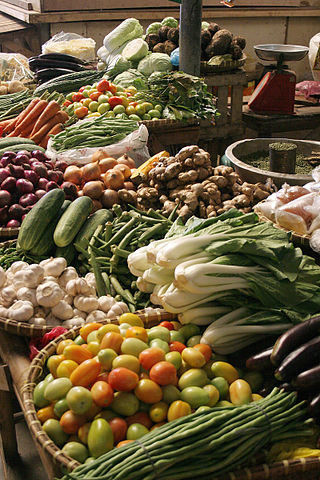
Vegetables are parts of plants that are consumed by humans or other animals as food. The original meaning is still commonly used and is applied to plants collectively to refer to all edible plant matter, including the flowers, fruits, stems, leaves, roots, and seeds. An alternative definition of the term is applied somewhat arbitrarily, often by culinary and cultural tradition. It may exclude foods derived from some plants that are fruits, flowers, nuts, and cereal grains, but include savoury fruits such as tomatoes and courgettes, flowers such as broccoli, and seeds such as pulses.
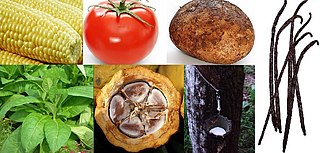
A crop is a plant that can be grown and harvested extensively for profit or subsistence. In other words, crop is a plant or plant product that is grown for a specific purpose such as food, fibre or fuel.

Inca cuisine originated in pre-Columbian times within the Inca civilization from the 13th to the 16th century. The Inca civilization stretched across many regions, and so there was a great diversity of plants and animals used for food, many of which remain unknown outside Peru. The most important staples were various tubers, roots, and grains. Maize was of high prestige, but could not be grown as extensively as it was further north. The most common sources of meat were guinea pigs and llamas, and dried fish was common.

In 2020, approximately 80% of Chad's labor force was employed in the agricultural sector. This sector of the economy accounts for 52.3% of the GDP, as of 2017. With the exception of cotton production, some small-scale sugar cane production, and a portion of the peanut crop, Chad's agriculture consists of subsistence food production.

Fijian cuisine has long consisted of primarily foraged and farm-grown food. Although rice, wheat, and tea all became staples during Fiji's colonial era, native Fijians still eat primarily tubers and coconuts. The cuisine of Fiji is known for its seafood and various green vegetables, including ''ota'', a young forest fern, and ''bele'', a plant that resembles spinach.

A grain is a small, hard, dry fruit (caryopsis) – with or without an attached hull layer – harvested for human or animal consumption. A grain crop is a grain-producing plant. The two main types of commercial grain crops are cereals and legumes.
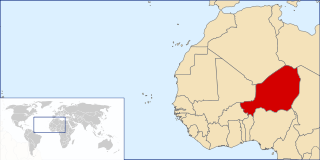
The cuisine of Niger draws on traditional African cuisines. Various spices are used and meals include grilled meat, seasonal vegetables, salads, and various sauces. Meals in Niger usually start with colorful salads made from seasonal vegetables. Moringa leaves are a favorite for a salad.

Chadian cuisine is the cooking traditions, practices, foods and dishes associated with the Republic of Chad. Chadians use a medium variety of grains, vegetables, fruits and meats. Commonly consumed grains include millet, sorghum, and rice as staple foods. Commonly eaten vegetables include okra and cassava. A variety of fruits are also eaten. Meats include mutton, chicken, pork, goat, fish, lamb and beef. The day's main meal is typically consumed in the evening on a large communal plate, with men and women usually eating in separate areas. This meal is typically served on the ground upon a mat, with people sitting and eating around it.

Central African cuisine includes the cuisines, cooking traditions, practices, ingredients and foods of the Central African Republic (CAR). Indigenous agriculture in the country includes millet, sorghum, banana, yam, okra, yellow onion, garlic, spinach, rice and palm oil. Imported crops of American origin include maize, manioc (cassava), peanuts, chili peppers, sweet potato and tomato. Additional foods include onions, garlic, chiles and peanuts.

This is a categorically-organized list of foods. Food is any substance consumed to provide nutritional support for the body. It is produced either by plants, animals, or fungi, and contains essential nutrients, such as carbohydrates, fats, proteins, vitamins, and minerals. The substance is ingested by an organism and assimilated by the organism's cells in an effort to produce energy, maintain life, or stimulate growth.
Ancient diet is mainly determined by food's accessibility which involves location, geography and climate while ancient health is affected by food consumption apart from external factors such as diseases and plagues. There are still a lot of doubt about this ancient diet due to lack of evidence. Similar to what anthropologist Amanda Henry has said, there are a lot of time periods in the human history but there are only theories to answer questions on what people actually ate then. Only recently have traces been discovered in what was left of these people.
The Future 50 Foods report, subtitled "50 foods for healthier people and a healthier planet", was published in February 2019 by the World Wide Fund for Nature (WWF) and Knorr. It identifies 50 plant-based foods that can increase dietary nutritional value and reduce environmental impacts of the food supply, promoting sustainable global food systems.


